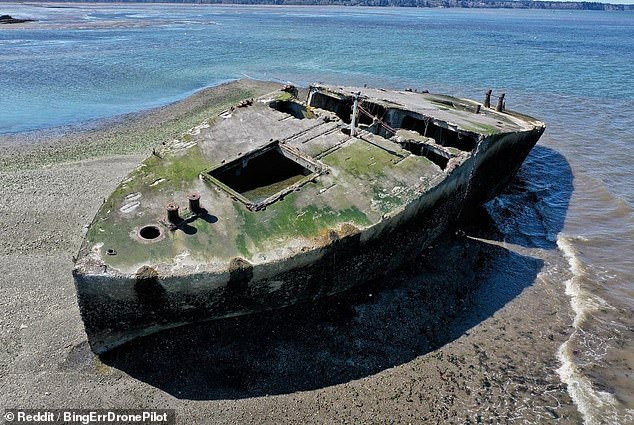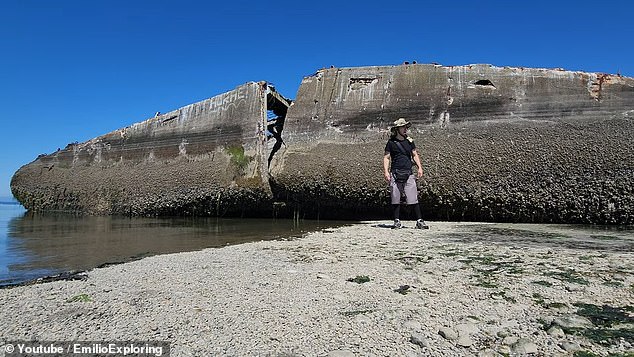Mystery of huge abandoned concrete block known as ‘The Cement Ship’ sitting on eerie sandbar off coast is finally solved
One of Washington state’s most enigmatic landmarks has been identified as the result of a short-lived experiment with concrete ships more than a century ago.
The “cement ship,” abandoned on a sandbar outside DuPont, has been confusing visitors to the area since the 1960s.
The enormous colossus has been split into two after decades of storming from the waters of Nisqually Reach and still attracts curious tourists who can walk there at low tide.
But the 100-foot vessel was launched as part of a bold effort to build ocean-going concrete “tank boats” to transport fresh water along the US coast in the years after World War I.
“The overarching circumstances at the time that led to America’s concrete shipbuilding program were a wartime scarcity of ships, combined with a shortage of steel,” wrote bloggers Richard Lewis and Erlend Bonderud.
“We are under no illusions that we are extremely, compulsively and quite eccentrically obsessed with this subject.”
The ‘cement ship’ lying abandoned on a sandbar outside DuPont has been confusing visitors to the area since the 1960s

But it started in 1919 as part of a fleet of ocean-going concrete “tank boats” designed to carry fresh water along the US coast.
The boat was named Captain Barker and was one of five built by the Great Northern Concrete Shipbuilding Company in the spring of 1919.
They cost $80,000 each – $1.4 million in today’s terms, and were designed to carry 52,000 liters of fresh water each.
They could be built quickly, but their heavy construction placed them low in the water and only two survived for more than a year, the rest being wrecked in storms.
“Seafarers in Portland smiled an ‘I told you so’ smile today when they heard of the disasters that overtook the Army tug Slocum and her escort of concrete ships off the coast of Oregon,” the News-Pilot reported in January 1920.
The stone boats were not well built for sea voyages, and the coastal voyage should never have been attempted, the sea captains said.’
Experimental boats made of concrete were first built in 1848 and the British Navy built and launched 64 of them immediately after World War I.
The US built 104 during World War II as it struggled to get Navy production going after the attack on Pearl Harbor. There are still seven left standing.
The 491-ton Captain Barker was launched on March 3, 1919, but was quickly docked for repairs after initial sea trials revealed steering problems.
The fleet was also dogged by the lack of internal bulkheads that allowed seawater to slosh around the already unstable boats.
The Captain Barker was towed from Vancouver to Astoria by the Slocum in January 1920 under Captain Enos Crawford.
It was put up for sale in October when the manufacturer filed for bankruptcy.
And it took more than 18 months before it found a buyer in the Rouse Towboat Company, who renamed it Foss 103 and used it as a sludge disposal vessel.
His inglorious career came to an end in the 1960s when the ship was sunk on the shore of Nisqually Reach, where it remains to this day.
Its only surviving sister ship, the Captain Bootes, had been sunk outside Everett in the 1950s.
But the wrecks of both boats have served as valuable breakwaters for half a century now, protecting their respective coastlines from tidal erosion, said Chris Staudinger, the co-founder of Pretty Gritty Tours.

The enormous hull has been split into two pieces after decades of storming from the waters of Nisqually Reach and still attracts curious tourists who can walk to it at low tide.
“This was especially beneficial for the action because it was concrete,” he told the newspaper Newsstand.
“They knew it would last longer.”
“During our research journey into concrete ships, we became acutely aware that the Internet is literally littered with urban myths, half-truths, fantasy and fiction about concrete ships,” Lewis and Bonderud wrote on their blog thecretefleet.com.
‘We are always looking for the tiniest clue as to where a concrete ship we know was built is today. We found literally hundreds of them.”
